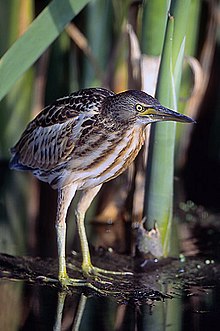Dummies
| Dummies | ||||||||
|---|---|---|---|---|---|---|---|---|

|
||||||||
| Systematics | ||||||||
|
||||||||
| Scientific name | ||||||||
| Botaurinae | ||||||||
| Reichenbach , 1850 |
The bitterns (Botaurinae) are a subfamily within the family of herons. The subfamily includes a total of 13 recent species in three genera, which are distributed almost worldwide and are only absent in the very cold regions of the world. A fourteenth species, the black-backed little bittern , became extinct before 1900. In Central Europe, the subfamily is represented by two species, namely the bittern and the little bittern .
The tommers differ from the day herons, the most species-rich subfamily within the herons, by a number of morphological characteristics and behavioral characteristics. The classification into a separate subfamily was confirmed by genetic tests. The South American zigzag heron , which for a long time belonged to the subfamily of the tiger heron , is now also counted among the tummers.
Appearance
All types of tommels are small to medium in size and have 10 tail feathers. The smallest species are found in the genus of the little bittern . The African gray-backed bittern , for example, only reaches a height of 27 to 30 centimeters and weighs 142 grams, while the American bittern , which occurs in both Americas , is up to 36 centimeters tall, but weighs less than 100 grams. The bitterns , which encompass four species, are medium-sized. In the Eurasian bittern, females weigh between 817 and 1,150 grams, the males between 966 and 1940 grams and reach a body length of 70 to eighty centimeters.
All species have a compact shape with a relatively short, thick neck for herons. The beak is relatively short and horn-colored, strong yellowish to yellowish-green and in a few species also blackish to black-green. Most species have a brownish plumage. The gray-backed bittern and the black bittern have the darkest plumage with their slate-colored to black-brown upper surface. What all species have in common is that the underside of the body is lighter than the top, and the chest and front neck show brownish longitudinal stripes in all species. Only the red bobble has, unlike the other species, only a dark longitudinal stripe.
Distribution, existence and habitat
Dommers are found in North and South America, Asia, Africa, Australia, New Zealand and Europe. Depending on the distribution area, they are migratory birds. A few populations remain in their breeding area all year round. In their way of life, dommers are bound to the water. Preferred habitat are dense belts of vegetation along fresh waters. The bitterns in particular need extensive reed belts. A dommel species can also be found in salt marshes and mangroves.
The population figures of most species of the little bittern are not clear due to their very hidden way of life. However, the species of the genus are classified as safe ( least concern ) by the IUCN .
Way of life
The food spectrum of the tommers is very broad and includes fish, crustaceans, frogs, tadpoles, insects and small mammals. The species nest solitary or in very loose colonies. The breeding time varies depending on the distribution area. The number of eggs varies between one and seven eggs.
Systematics
The following species are included in the subfamily of the tommels:
- Genus bittern , botaurus
- South American bittern , Botaurus pinnatus
- North American bittern , Botaurus lentiginosus
- Bittern , Botaurus stellaris
- Australian bittern , Botaurus poiciloptilus
- Genus bittern , Ixobrychus
- Striped bobbin , Ixobrychus involucris
- American bittern , Ixobrychus exilis
- Little bittern , Ixobrychus minutus
- Chinadommel , Ixobrychus sinensis
- Von schrenck's bittern , Ixobrychus eurhythmus
- Cinnamon bobble , Ixobrychus cinnamomeus
- Gray-backed bobbin , Ixobrychus sturmii
- Black bittern , Ixobrychus flavicollis
- † Black-backed little bittern , Ixobrychus novaezelandiae
- Genus Zebrilus
- Zigzag Heron , Zebrilus undulatus
supporting documents
Single receipts
- ↑ BirdLife Factsheet on Ixobrychus novaezelandiae accessed September 20, 2009
- ↑ Kushlan et al., P. 329
- ↑ Kushlan et al., P. 310
- ↑ Kushlan et al., P. 296
- ↑ BirdLife Factsheet on the Australian Bittern , accessed September 13, 2009
literature
- James A. Kushlan & James A. Hancock: Herons . Oxford University Press, 2005, ISBN 0-19-854981-4
